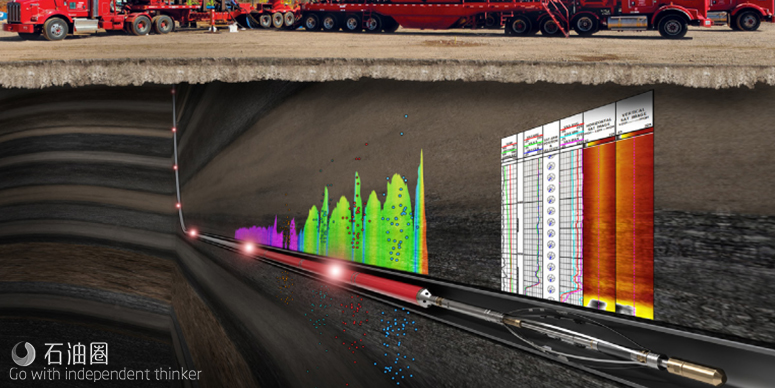Halliburton has introduced SPECTRUM FUSION service, the newest offering in the SPECTRUM family of real-time coiled tubing services. The FUSION service includes the first real-time system in the market using hybrid cable technology that combines fiber optic and electric to provide downhole communication and continuous power for a variety of diagnostic applications. The cable is conveyed through coiled tubing to deliver intervention, diagnostic and reservoir assessment services in one trip downhole to help customers achieve greater efficiency, safer operations and a higher return on investment.
Since the 2016 launch of SPECTRUM Real-Time Coiled Tubing Services, Halliburton has seen a rapid increase in the demand for diagnostic and intervention services. The SPECTRUM family of services has been the fastest-growing segment in the company’s coiled-tubing business with operations in more than 10 countries. The family of services is designed to deliver more accurate and effective interventions by capturing data such as weight on bit, pressure, temperature and acoustics, with casing collar locator and gamma ray for depth correlation in real time.
The SPECTRUM FUSION service is the new enhanced platform for real-time coiled tubing services that eliminates runs and reduces surface footprint by integrating full wireline capability with downhole intervention tools. The FUSION service combines the existing insight from fiber optics inside the coil with power from the surface creating versatility in selecting logging tools. It also enables customers to diagnose wellbore conditions in real time and customize the wellbore treatment or intervention operation using the data transmitted to the surface.
David Adams, Halliburton Senior Vice President for the Completion and Production Division said, “Given the increasing complexity of developing mature fields and offshore environments, the SPECTRUM FUSION service’s unique combination of coiled tubing intervention and wireline diagnostic capability provides critical downhole data for customizing well intervention, reducing risk and maximizing services performed in a single run.”
SPECTRUM FUSIONSM,Real-Time Hybrid Coiled Tubing Service
INTEGRATED WELL DIAGNOSTICS AND INTERVENTIONS
Halliburton’s SPECTRUM FUSIONSM is the new generation of real-time hybrid coiled tubing services. The hybrid system combines intervention and diagnostic capabilities to help operators deliver better wells.
SPECTRUM FUSION service is a step change in the industry by integrating fiber optic and electric communication and power. The system is fully compatible with wireline and mechanical tools, offering unlimited flexibility in diagnostic, design and delivery of the operations.
When equipped with the SPECTRUM FUSION platform, coiled tubing operations are entering a new era of collaboration, informed interventions, and real-time onsite decision-making process for more precise and reliable execution and maximized well performance.
BENEFITS
» Integrated logging capability – SPECTRUM FUSION service can deploy all cased-hole logging tools, in addition to distributed temperature sensing (DTS) and distributed acoustic sensing (DAS), for maximum subsurface insight.
» Open architecture – The system is designed to be compatible with all electric and mechanical tools, helping provide the best solutions for solving industry challenges.
» No power limitation – Due to the hybrid electric and fiber optic concept, no battery is required, so operations are not limited by time or power constraints.
» Enhanced single trip – The ultra compact design of the bottomhole assembly (BHA) provides the ability to combine with additional intervention and diagnostic tools in the same trip. Tractors and dummy runs can also be eliminated.
» Fast rig-up – SPECTRUM FUSION service provides a step change for rig-up efficiency with plug and play connections, eliminating nonproductive time (NPT).
» Transparent to operations – The system is robust and compatible with acid, solvents, and abrasive fluids. It eliminates the need to have a work reel and logging reel.
» Enhanced logistics – With combined coiled tubing and wireline capabilities, SPECTRUM FUSION service streamlines logistical work flows to reduce operational time and limit footprints on locations.
As more operators in unconventional basins adopt chemical diverting technology as part of their stimulation treatments, operators have been focused on achieving optimum cluster completion efficiency. Cluster efficiency describes the percentage of clusters that receives effective stimulation for a given interval. Previously, there were limited methods available to provide accurate and consistent data to evaluate the entire length of the wellbore. SPECTRUMSM Diagnostic Services quantifies fracture initiation points across the wellbore, validating the effectiveness of a fracture treatment.
A major operator used SPECTRUM Diagnostic Services to evaluate two wells that had been completed with unique stimulation designs. One well was treated with AccessFrac®Stimulation Service, and the other was stimulated with a standard customer design. SPECTRUM Diagnostic Services was deployed after each stimulation treatment. The fiber-optic analysis determined that, by using diverter technology, greater stimulation cluster efficiency was achieved and the completion design was optimized by reducing the number of intervals in the well.
CHALLENGE
The operator had two cemented lateral wells (Well A and Well B) on the same pad that were completed using different stimulation techniques. Well A was completed with 20 stages, using a hybrid fracture design with diverter technology. Well B was treated with 28 stages, using a similar fracture treatment, but no chemical diverter was employed. The operator needed a method to determine the relative effectiveness of treatment across the wellbore and the impact of diversion on stimulation performance.
SOLUTION
SPECTRUM Diagnostic Services was used to assess the fluid distribution across each well and to determine the optimum stimulation treatment. Fiber-optic distributed temperature sensing (DTS) and distributed acoustic sensing (DAS) results helped evaluate the stimulation cluster efficiency of each well 40 days after the wells had been treated. For each well, all stimulated intervals were evaluated simultaneously in a single trip, providing reliable evaluation of cluster efficiency in real time.
RESULTS
Data acquired after the wells were completed indicated that the number of fracture initiation points for Well A was 20 percent greater than those for Well B. The operator was able to lower stimulation costs, reduce time spent completing the well by pumping fewer stages, and achieve better well performance based on the insights gained from SPECTRUM Diagnostic Services.

 石油圈
石油圈
